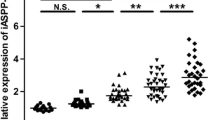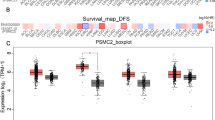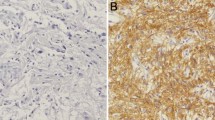Abstract
Glioma is the most common intracranial malignant tumor. Low-grade gliomas (LGG) occupy almost 80% in all of the gliomas. The prognosis of LGG in children is much better than in adult, however, the molecular mechanism is still unclear. In our investigation, it was first found that the level of soluble IL1RAP (sIL1RAP) was significantly higher in the LGG from children than that from adult. We also revealed that sIL1RAP could induce the apoptosis of U251. In cells with overexpression of sIL-1RAP, the cell proliferation promoted by IL-1 was significantly inhibited. These decreased tumor growth ability and better prognosis of low-grade gliomas in children patients than that in adult patients. The expression level of sIL1RAP may become one of the potential indexes for determining the prognosis of low-grade gliomas.





Similar content being viewed by others
References
Jiang T, Mao Y, Ma W, Mao Q, You Y, Yang X et al (2016) CGCG clinical practice guidelines for the management of adult diffuse gliomas. Cancer Lett 375:263–273
Qaddoumi I, Sultan I, Gajjar A (2009) Outcome and prognostic features in pediatric gliomas. Cancer 115:5761–5770
Jubelirer SJ, Rubin M, Shim C (1993) An analysis of 38 cases of low-grade cerebral astrocytoma adults. W Va Med J 89:102–105
Pollack IF, Claassen D, Al-Shboul Q, Janosky JE, Deutsch M (1995) Low-grade gliomas of the cerebral hemispheres in children: an analysis of 71 cases. J Neurosurg 82:536
Vecht CJ (1993) Effect of age on treatment decisions in low-grade glioma. J Neurol Neurosurg Psychiatry 56:1259
Rickert CH, Paulus W (2001) Epidemiology of central nervous system tumors in childhood and adolescence based on the new WHO classification. Childs Nerv Syst Chns Off J Int Soc Pediatr Neurosurg 17:503–511
Noël G, Mazeron JJ (2002) Randomized trial on the efficacy of radiotherapy for cerebral low-grade glioma in the adult: European Organization for Research and Treatment of Cancer Study 22845 with the Medical Research Council study BRO4: an interim analysis: A.B. Karim, D. Afra. P C Cancer 6:322–323
Shaw E, Arusell R, Scheithauer B, O’Fallon J, O’Neill B, Dinapoli R et al (2002) Prospective randomized trial of low- versus high-dose radiation therapy in adults with supratentorial low-grade glioma: initial report of a North Central Cancer Treatment Group/Radiation Therapy Oncology Group/Eastern Cooperative Oncology Group study. J Clin Oncol Off J Am Soc Clin Oncol 20:2267
Merchant TE, Pollack IF, Loeffler JS (2010) Brain tumors across the age spectrum: biology, therapy, and late effects. Semin Radiat Oncol 20:58–66
Durmaz R, Vural M, Işildi E, Coşan E, Ozkara E, Bal C et al (2008) Efficacy of prognostic factors on survival in patients with low grade glioma. Turk Neurosurg 18:336–344
Stokland T, Liu JF, Ironside JW, Ellison DW, Taylor R, Robinson KJ et al (2010) A multivariate analysis of factors determining tumor progression in childhood low-grade glioma: a population-based cohort study (CCLG CNS9702). Neuro-Oncology 12:1257
Pignatti F, Bent MVD, Curran D, Debruyne C, Sylvester R, Therasse P et al (2002) Prognostic factors for survival in adult patients with cerebral low-grade glioma. J Clin Oncol Off J Am Soc Clin Oncol 20:2076–2084
Jubelirer SJ, Rubin M, Shim C (1993) An analysis of 38 cases of low-grade cerebral astrocytoma in adults. W V Med J 89:102–105
Askmyr M, H Å, Hansen N, Gordon S, Arvanitakis A, Rissler M et al (2013) Selective killing of candidate AML stem cells by antibody targeting of IL1RAP. Blood 121:3709–3713
Gerber JM, Gucwa JL, Esopi D, Gurel M, Haffner MC, Vala M et al. (2013) Genome-wide comparison of the transcriptomes of highly enriched normal and chronic myeloid leukemia stem and progenitor cell populations. Oncotarget 4:715–728
Xing S, Wanning HU, Zhao X, Liu W, Gong J (2013) Interleukin 1 receptor accessory protein contributes to children and adult low grade gliomas. J Cap Med Univ 34:258 – 63
Sun ZF, Wen-Liang LI, Feng GU (2011) Research progression of mechanisms in glioma chemoresistance. Chin J Cancer Prev Treat 18:551–556
Zhu H, Lei X, Zhang F, Wang Y (2012) A meta-analysis of risk factors for gliomas and incidence change after controlling risk factors. J China Med Univ 41:554–558
Guo Z, Gong J, Wang J, Liu W, Wanning HU, Xing S et al. (2015) Role of IL-1RAP in Gliomas Cells and Its Relationship with STAT3. Cancer Res Prev Treat 42:23–27
Zhou M, Li X, Li G (2006) Molecular mechanism and progress of protein transport from cytoplasm to nucleus. Chin J Biochem Mol Biol 22:780–786
Dale M, Hammond DW, Cox A, Nicklin MJ (1998) The human gene encoding the interleukin-1 receptor accessory protein (IL1RAP) maps to chromosome 3q28 by fluorescence in situ hybridization and radiation hybrid mapping. Genomics 47:325–326
Subramaniam S, Stansberg C, Cunningham C (2004) The interleukin 1 receptor family. Dev Comp Immunol 28:415–428
Huang J, Gao X, Li S, Cao Z (1997) Recruitment of IRAK to the interleukin 1 receptor complex requires interleukin 1 receptor accessory protein. Proc Natl Acad Sci USA 94:12829–12832
Jensen LE, Muzio M, Mantovani A, Whitehead AS (2000) IL-1 signaling cascade in liver cells and the involvement of a soluble form of the IL-1 receptor accessory protein. J Immunol 164:5277
Smith DE, Hanna R, Friend D, Moore H, Chen H, Farese AM et al (2003) The soluble form of IL-1 receptor accessory protein enhances the ability of soluble type II IL-1 receptor to inhibit IL-1 action. Immunity 18:87
Martinon F, Mayor A, Tschopp J (2009) The inflammasomes: guardians of the body. Annu Rev Immunol 27:229
Farasat S, Aksentijevich I, Toro JR (2008) Autoinflammatory diseases: clinical and genetic advances. Arch Dermatol 144:392–402
Dinarello CA (1996) Biologic basis for interleukin-1 in disease. Blood 87:2095
Hestdal K, Ruscetti FW, Chizzonite R, Ortiz M, Gooya JM, Longo DL et al. (1994) Interleukin-1 (IL-1) directly and indirectly promotes hematopoietic cell growth through type I IL-1 receptor. Blood 84:125–132
Greenfeder SA, Nunes P, Kwee L, Labow M, Chizzonite RA, Ju G (1995) Molecular cloning and characterization of a second subunit of the interleukin 1 receptor complex. J Biol Chem 270:13757
Kim HS, Kim MS, Hancock AL, Harper JC, Park JY, Poy G et al (2007) Identification of novel Wilms’ tumor suppressor gene target genes implicated in kidney development. J Biol Chem 282:16278
Ågerstam H, Karlsson C, Hansen N, Sandén C, Askmyr M, Von PS et al (2015) Antibodies targeting human IL1RAP (IL1R3) show therapeutic effects in xenograft models of acute myeloid leukemia. Proc Natl Acad Sci USA 112:10786–10791
Prieto GA, Snigdha S, Baglietto-Vargas D, Smith ED, Berchtold NC, Tong L et al (2015) Synapse-specific IL-1 receptor subunit reconfiguration augments vulnerability to IL-1β in the aged hippocampus. Proc Natl Acad Sci USA 112:E5078
Yoshida T, Shiroshima T, Lee SJ, Yasumura M, Uemura T, Chen X et al. (2012) Interleukin-1 receptor accessory protein organizes neuronal synaptogenesis as a cell adhesion molecule. J Neurosci Off J Soc Neurosci 32:2588–2600
Yasumura M, Yoshida T, Yamazaki M, Abe M, Natsume R, Kanno K et al (2014) IL1RAPL1 knockout mice show spine density decrease, learning deficiency, hyperactivity and reduced anxiety-like behaviours. Sci Rep 4:6613
Huang Y, Smith DE, Ibáñezsandoval O, Sims JE, Friedman WJ (2011) Neuron-specific effects of interleukin-1ß are mediated by a novel isoform of the IL-1 receptor accessory protein. J Neurosci Off J Soc Neurosci 31:18048–18059
Järås M, Fioretos T (2010) Isolation and killing of candidate chronic myeloid leukemia stem cells by antibody targeting of IL-1 receptor accessory protein. Proc Natl Acad Sci USA 107:16280–16285
Yılmaz-Eliş AS, Aartsma-Rus A, tH PA, Safdar H, Breukel C, van Vlijmen BJ et al (2013) Inhibition of IL-1 signaling by antisense oligonucleotide-mediated exon skipping of IL-1 receptor accessory protein (IL-1RAcP). Mol Ther Nucl Acids 2:e66
Acknowledgements
Supported by National Natural Science Funding (31271119), Beijing, a high-level technical talents cultivation plan in the Beijing Municipal Planning Commission Funding (2013-3-045).
Author information
Authors and Affiliations
Corresponding author
Ethics declarations
Conflict of interest
The authors have no financial or personal relations that could pose a conflict of interest.
Rights and permissions
About this article
Cite this article
He, J., Li, X., Zhu, W. et al. Research of differential expression of sIL1RAP in low-grade gliomas between children and adults. Brain Tumor Pathol 35, 19–28 (2018). https://doi.org/10.1007/s10014-017-0304-x
Received:
Accepted:
Published:
Issue Date:
DOI: https://doi.org/10.1007/s10014-017-0304-x




